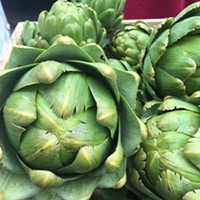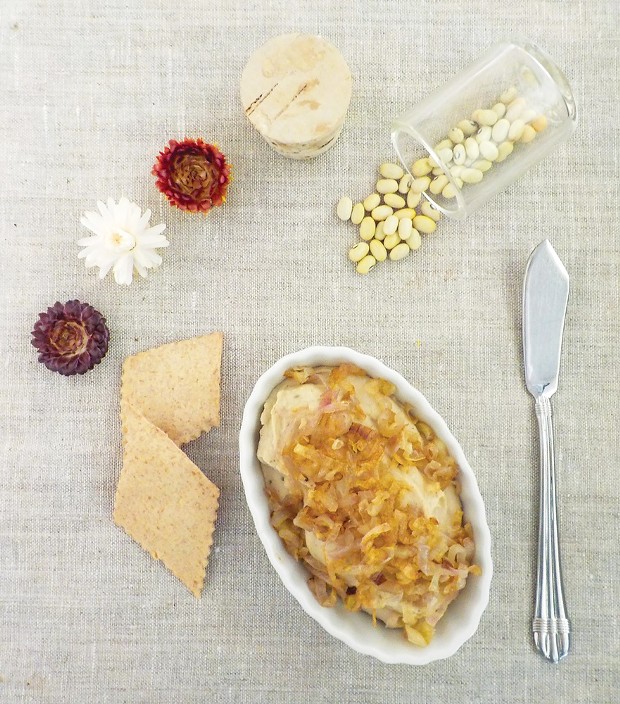[
{
"name": "Top Stories Video Pair",
"insertPoint": "7",
"component": "17087298",
"parentWrapperClass": "fdn-ads-inline-content-block",
"requiredCountToDisplay": "1"
}
]
We made it to April and to the 2021 edition of the Arcata Plaza Farmers Market's main season, which started the first Saturday of this month. This is always a festive event for me, and this year was no different. While summer produce is not exactly around the corner, I can start dreaming of strawberries, cherry tomatoes, eggplant, melons and all the other fruit and vegetables I love.
In the meantime, I have been making large salads of lettuce, roasted red beets and radishes, and batches of fasole bătută, a traditional Romanian bean spread. Unlike Louisa Rogers, who recently transported us to Nepal with a spoon of lentil soup ("Lentils: The great leveler," March 25), I cannot bring you to Romania on a slice of bread topped with bean spread. I have never traveled to that country and cannot describe the various versions of fasole bătută I would have tasted had I visited. I only know about my rendition. After first making this simple, flavorful spread some years ago, a Romanian whom I met through my blog described fasole bătută as the most beloved (and most eaten) dish in her home country: "as appetizer on a slice of bread, or as side dish to accompany a sausage, or as vegetarian entrée by itself, or with a side of pickled vegetables, like cucumbers and green tomatoes." I understand and share Romanians' enthusiasm for fasole bătută. I sometimes eat it straight from the bowl with a teaspoon.
Geographically part of Eastern Europe, Romania has one characteristic that sets it apart from neighboring countries: Its language is not Slavic, but Romance, belonging to the Italic branch of the Indo-European language family, and it has therefore much in common with my mother tongue Italian. The scientific name for beans is Phaseolus vulgaris, the Italian one is fagioli and the Romanian fasole.
I have made this dish with various beans. Originally, I used Paul's Mix, a blend of all the varieties of beans Paul Giuntoli grew at Warren Creek Farms. I have also used other types of beans, like canario and, most recently, Kenearly yellow eye from Rain Frog Farm and black coco from Earthly Edibles. The nice thing is that each type of bean imparts a slightly different flavor to the dish.
I used to soak beans but stopped doing that some years ago. It takes longer to cook them, but I don't mind letting the pot with beans and aromatics murmur quietly in the background, or setting a reminder to periodically check their progress.
I like fasole bătută; it's creamy and balanced in terms of flavor. It makes a great appetizer, served with bread (particularly rye bread) or crackers, or as accompaniment to other dishes, like a hearty salad, a plate of sautéed mushrooms or stewed leafy greens.
Fasole bătută
This is my version (with personal touches) of a traditional Romanian bean spread.
Makes 1 ¼ cup (the photo shows half of the amount). The recipe can be easily doubled.
Ingredients:
½ cup or 3 ½ ounces dry beans of choice
2 cups of water
½ small onion, halved
1 small bay leaf
1 small clove of garlic, peeled and sliced
2 sprigs of fresh parsley
1/8 teaspoon fine sea salt
2 teaspoons fresh lemon juice
1 teaspoon finely minced fresh dill or parsley
1 small garlic clove (emphasis on small), peeled and minced
1/8 teaspoon fine sea salt
1 pinch of freshly ground pepper
1 tablespoon extra-virgin olive oil
3 ounces shallots
1 tablespoon extra-virgin olive oil
Place the beans in a small saucepan with the water, onion, bay leaf, garlic, parsley and salt. Bring the water to a lively boil, then turn down the heat and let the beans simmer covered until they are tender. Let the beans cool in their cooking broth, then remove the aromatics and discard them. Let the beans rest in their broth until ready to use.
Drain the beans saving the cooking broth. Place the beans in a food processor fitted with a steel blade. Add two tablespoons of the cooking broth, the lemon juice, dill or parsley, garlic, salt and pepper, and start the processor. When the beans are partially mashed, add the olive oil. Scrape the side of the bowl with a spatula to make sure the ingredients are processed evenly.
Process the beans until creamy. Add more of the cooking liquid, if needed, for the desired spreadable consistency. Transfer to a bowl and refrigerate until use.
Peel the shallot and cut it in half lengthwise. Cut each half into 1/8-inch-thick slices. In a small frying pan, warm up the tablespoon of olive oil over medium heat, then add the shallots. Cook over very low heat until soft, stirring often. Let cool.
Take the fasole bătută out of the refrigerator ahead of serving so it is not too cold. Just before bringing it to the table, top it with the shallots.
Speaking of...
-

Eureka Friday Night Markets are Here
Jun 29, 2023 -

Resolutions for a Better Food Life
Jan 20, 2022 -

Farmers and Customers Adjusting to COVID-19 Safety Guidelines
May 23, 2020 - More »
more from the author
-
More than a Farmstand
Sea Goat grows into a McKinleyville hub
- Jul 18, 2024
-
When Nature Gives You Rain, Visit a Waterfall
A hike to Trillium Falls and beyond
- May 16, 2024
-
A Green Dish for Earth Day or Any Day
- Apr 18, 2024
- More »
































